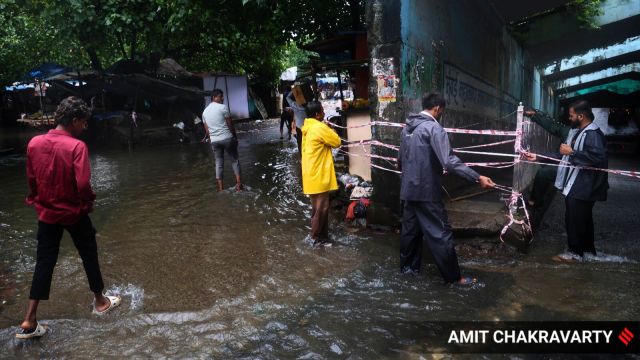What 5 days of manic rain have done to Mumbai: Monsoon rainfall figure touches seasonal average with 40 days remaining
Mumbai received 870 mm rainfall over the last five days, making this August the wettest since 2020.
 Water levels have receded at Maharashtra Nagar in Mankhurd (East), but remnants of the severe waterlogging from the past two days persist. (Express Photo by Amit Chakravarty)
Water levels have receded at Maharashtra Nagar in Mankhurd (East), but remnants of the severe waterlogging from the past two days persist. (Express Photo by Amit Chakravarty)Despite a third of the monsoon season still remaining this year, the Santacruz station in Mumbai has already recorded 2,320.8 mm rainfall by Wednesday evening, surpassing the average rainfall of 2,319 mm that the observatory receives from June to September.
The city surpassed its average quota for the season in less than three months, after the torrential downpour that whipped Mumbai this week — in the past five days alone, the city received over 870 mm rain.
Mumbai largely receives its annual quota of rain during the four monsoon months between June and September.
Of this, the maximum showers are recorded in the month of July, which generally receives 855 mm rain, followed by 537 mm rain in the month of June.
Meanwhile, the Colaba station is currently languishing under a deficit, having received 1,512 mm rain until now since June.
Data shows that over the last five years, Mumbai has consistently witnessed a higher than average rainfall.
While it was 3,016 mm in 2024, it was 2,978 mm in 2023 between June to September.
Following days of incessant rainfall over the past few days, rain activity subdued considerably on Wednesday when the IMD had placed Mumbai under an orange alert.
According to the weather bureau, after heavy rainfall in isolated pockets on Thursday, rain activity is slated to further subside from Friday across the Mumbai Metropolitan Region (MMR) with no alerts issued for the city and its neighbouring districts until at least the weekend.
After reeling under an extended period of dry spell, heavy showers swept the region, starting the night of August 15.
In the past five days, the city has received over 200 mm rain in at least three days.
For instance, the city received 245 mm rain on August 16 morning, followed by 238 mm rain on August 19 as well as 209 mm rain between Tuesday and Wednesday morning.
Cumulatively, the city has received nearly 880 mm rain between August 15 night and Wednesday evening, while the city has also clocked in over 1,000 mm rain, this August. Owing to rain continuing unabated, this has also become the city’s wettest August since 2020, when Santacruz received 1,240 mm rain during the month.
This is in stark contrast to the months of June and July when the Santacruz station had registered rain deficits as the city failed to meet its average quota of rain for the month.
While the city generally receives 537 mm average rain in June, this year, the suburban station only clocked in 512 mm rain during the month.
In July too, despite typically being the city’s wettest month of the year, Mumbai only received 798 mm rain as against the month’s average quota of 855 mm — making it Mumbai’s driest July since 2015.
The suburban station has recorded 2689 mm rain until now owing to the unseasonal downpour and a historic early monsoon onset in May, this year.
Meteorologists attributed the wet spell over the past few days to a combination of active weather systems, which ushered in moisture into the region.
Several systems which are conducive to monsoon such as a monsoon trough, a depression, an upper air cyclonic circulation, a shear zone as well as an offshore trough were active in the region, in what led to the resurgence of monsoon currents.
Seasonal rainfall recorded over last 5 years by Santacruz observatory
2024: 3,016 mm
2023: 2,978.3 mm
2022: 2,652 mm
2021: 3,163 mm
2020: 3,759.7 mm







